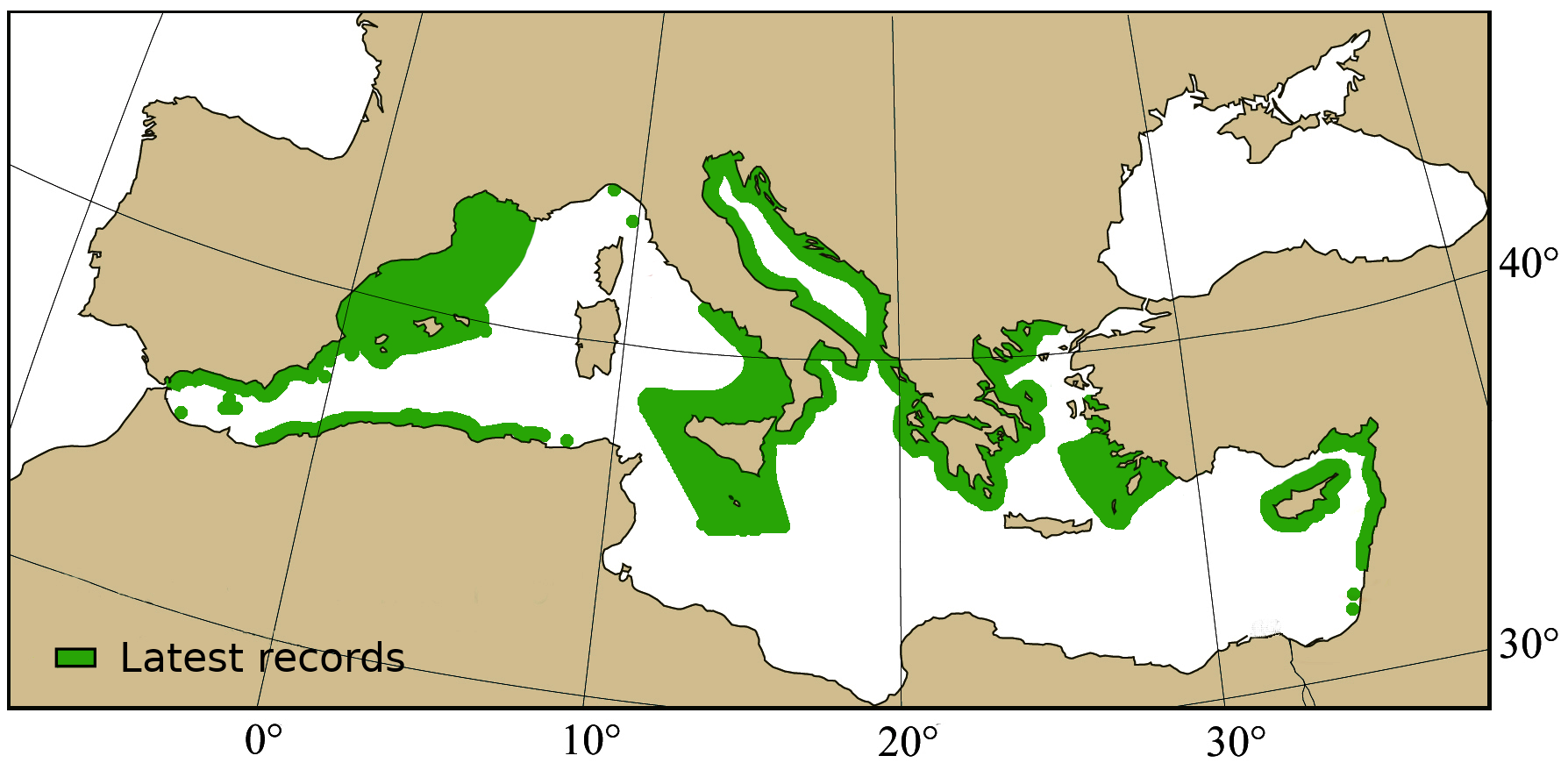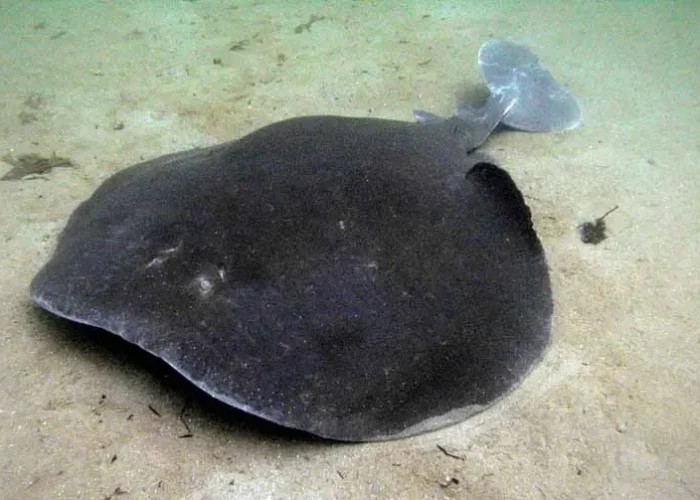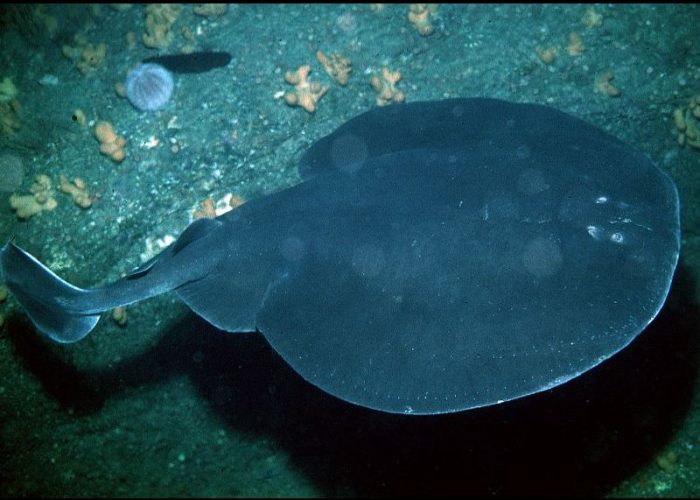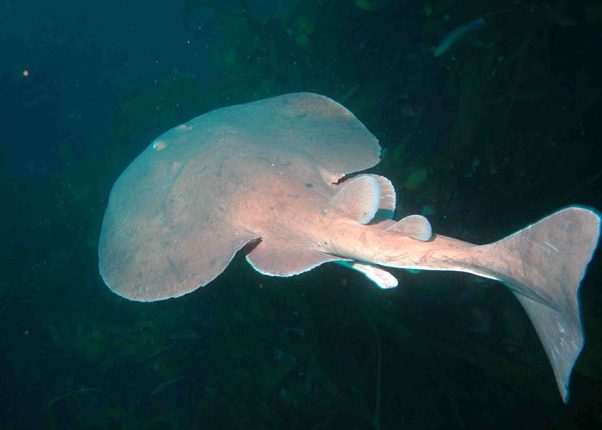Tetronarce nobiliana
Common name: Great Torpedo Ray, Electric ray
Order: Torpediniformes
Family: Torpedinidae
Synonyms: Torpedo (Tetronarce) nobiliana
Misidentifications: None.
Short description
Very large ray with a disc nearly circular. Short snout. No papillae around spiracles. Short and thick tail with two dorsal fins (the first one more developed than the second) and a very large caudal fin. Smooth skin.
Color: Dark purple, brown or black dorsal surface, often with dark margins on the disc and pelvic fins. White to cream ventral surface, occasionnaly with dark margins.
Measurements:
- Total length (TL): up to 180 cm.
- Weight: up to 90 kg.
Swimming pattern: Axial-undulatory locomotion.
Biology / Ecology
Feeds mainly on bony fishes. Capable of inflicting a severe shock of up to 200 volts for attack and defence.
Behaviour: Solitary.
Reproduction: Viviparous (aplacental viviparity with histotrophy). Feed mainly on bony fishes. Males mature at ~ 60 cm TL (South Pacific). Gestation period of ~1 year. Up to 60 juveniles per litter. Size at birth (TL): 23 cm.
Habitat: Juveniles benthic on soft bottoms (usually 10 – 150 m) while adults have a wide depth distribution from the surface to 800 m and have been reported to migrate over long distances.
The genus Tetronarce is represented by a single species in the Mediterranean Sea, easy to identify with its characteristic dark blue pattern.
Distinguishing characteristics
- Dorsal surface totally dark purple or dark brown (or black), without spot.
- No papillae around spiracles.
Torpedinidae: Greatly enlarged pectoral fin. Large oval-shape disc. Electric organ on each side of the head.
Distribution
Worldwide: Northwestern Atlantic and eastern Atlantic from North Sea to South Africa. Absent from Black Sea.
Mediterranean: Patchy distribution in the Mediterranean Sea.
- Occurrence: Occasional/Rare.
- Latest records: Cyprus (2018-2022), Albania (2018), Gulf of Lion – France (2013), Lebanon (2013), Mersin bay – Turkey (2013), Greek (2008), Cyprus (2006), Algeria (2004), Dodecanese waters – Turkey (1998)
- Locally extinct: Upper Tyrrhenian Sea (1922).

Any recent observation not on the map?
Contact us!
Conservation
Threats: Taken as bycatch mainly by trammel nets.
Protection level:
- Global: Least Concern (IUCN 2021, last assessment: 2020)
Key references
- Capapé C., Guélorget O., Vergne Y., Quignard J.P. 2006. Biological observation on the black torpedo, Torpedo nobiliana Bonaparte 1835 (Chondrichthyes: Torpedinidae), from two Mediterranean areas. Annales, Series Historia Naturalis 16:19-28.
- Carpentieri P., Nastasi A., Sessa M., Srour A. 2021. Incidental catch of vulnerable species in Mediterranean and Black Sea fisheries – A review. General Fisheries Commission for the Mediterranean – Studies and Reviews 101: I-317.
- Ferretti F., Osio G.C., Jenkins C.J., Rosenberg A.A., Lotze H.K. 2013. Long-term change in a meso-predator community in response to prolonged and heterogeneous human impact. Scientific Reports 3: 1057.
- Follesa M. C., Marongiu M. F., Zupa W., Bellodi A., Cau A., Cannas R., Colloca F., Djurovic M., Isajlovic I., Jadaud A., Manfredi C., Mulas A., Peristeraki P., Porcu C., Ramirez-Amaro S., Salmerón Jiménez F., Serena F., Sion L., Thasitis I., Cau A., Carbonara P. 2019. Spatial variability of Chondrichthyes in the northern Mediterranean. Scientia Marina 83(S1): 81-100.
- Giovos I., Serena F., Katsada D., Anastasiadis A., Barash A., Charilaou C., Hall-Spencer J.M.,Crocetta F.,Kaminas A., Kletou D, Maximiadi M., Minasidis V., Moutopoulos D.K., Aga-Spyridopoulou R.N., Thasitis I., Kleitou P. 2021. Integrating literature, biodiversity databases, and citizen-science to reconstruct the checklist of Chondrichthyans in Cyprus (Eastern Mediterranean Sea). Fishes 6(3): 24.
- Mulas, A., Bellodi, A., Carbonara, P., Cau, A., Marongiu, M. F., Pesci, P.,Porcu C., Follesa, M.C. 2021. Bio-ecological features update on eleven rare cartilaginous fish in the Central-Western Mediterranean Sea as a contribution for their conservation. Life 11(9): 871.
- O’Keefe M., Bengil EG., Palmer JL, Beton D, Çağlar Ç., Godley B.J, Özkan M., Snape R.T.E., Broderick A.C. 2023. Diversity and distribution of elasmobranchs in the coastal waters of Cyprus: using bycatch data to inform management and conservation. Front. Mar. Sci. 10: 1181437.
- Ordines F., Massutí E., Moranta J., Quetglas A., Guijarro B., Fliti K. 2011. Balearic Islands vs Algeria: two nearby western Mediterranean elasmobranch assemblages with different oceanographic scenarios and fishing histories. Scientia Marina 75(4): 707-717.
- Ramírez-Amaro S., Ordines F., Esteban A., García C., Guijarro B., Salmerón F., Terrasa B., Massutí E. 2020. The diversity of recent trends for chondrichthyans in the Mediterranean reflects fishing exploitation and a potential evolutionary pressure towards early maturation. Scientific Reports 10(1): 1-18.



